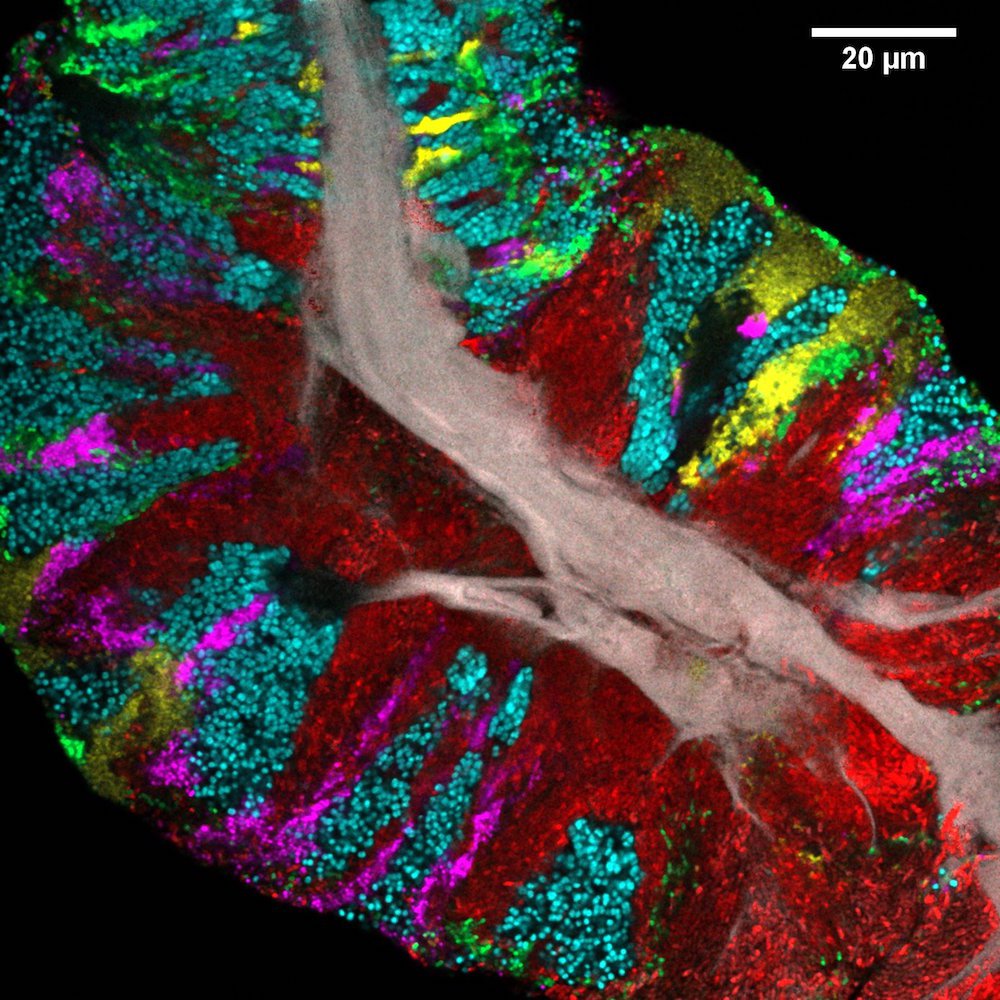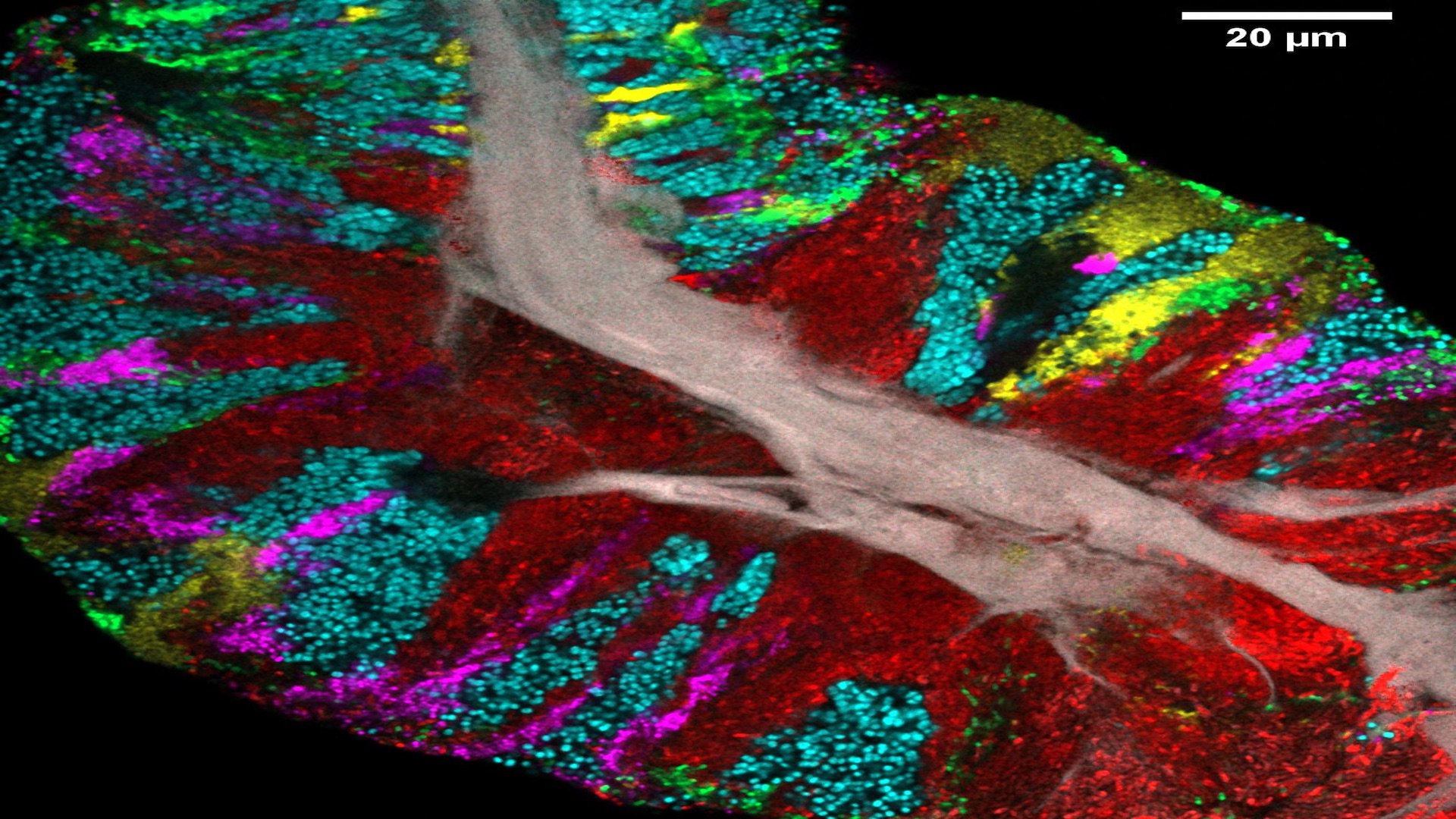By Eva Kneepkens, De Volkskrant (2 April 2020)
A clique of bacteria
If you don’t know what you’re looking at, the image looks like the colourful leaf of an exotic plant. But experts know this mosaic shows a tongue cell surrounded by a clique of bacteria. This image was made by American biologist Gary Borisy, Forsyth Institute and Harvard School of Dental Medicine, and geneticist Jessica Mark Welch, Marine Biological Laboratory in Woods Hole. Using a new technique, they were the first to succeed in describing how tongue bacteria live together as neighbours. The study was published in Cell Reports on 25 March.
These large quantities of bacteria don’t just live on our tongue and in our mouth for no good reason. They also play an important role in digesting our food and in the development of our immune system. However, they can have negative effects on our body, too. The mouth bacterium Porphyromonas gingivalis, for instance, is associated with Alzheimer’s disease, as De Volkskrant reported last year.
You might think that combatting this one ‘bad guy’ would be an obvious solution. Unfortunately things aren’t that simple. The oral microbiome – which besides the bacteria also comprises other little inhabitants such as fungi, viruses and amoeba – is an ecosystem in which all kinds of complex interdependencies play a role: if you knock one villain on the head, then this might cause some good guys to disappear as well. ‘If you want to get rid of a certain type of bacteria, then it’s important to know which other types live alongside it and whether these neighbours will help or whether they’re waiting to move into the empty space’, says Welch.

A CLASI-FISH image of a small section of bacterial biofilm from the tongue. Human tongue cells form the grey core. (credit: Steven Wilbert and Gary Borisy, The Forsyth Institute).
‘Over the past ten years researchers have learned more and more about the oral microbiome’s importance for our health . The only thing is, every crumb of knowledge gives rise to at least as many new questions’, says Borisy. Their image does exactly this, too. Because how do tongue bacteria ‘choose’ their neighbours? Borisy and Welch hope to understand this in the near future. For the time being, the mosaic image remains above all a useful item for integrating all available knowledge about our little tongue residents. Below we provide three examples of things we now know about the lives and times of our tongue residents.
Don’t do this: rinsing with antibacterial mouthwash
Rinsing out your mouth every morning with mouthwash. Fresh and clean, right? Well, actually not a good idea. At least, not if it’s mouthwash with an antibacterial effect. This kills not only undesirable bacteria but also the good bacteria which, for instance, h elp to keep down blood pressure . Various studies have shown that the blood pressure of test subjects rises slightly when they regularly rinse with bactericidal mouthwash over a certain period. This is because these blood-pressure-reducing bacteria can do something that our own body cells can’t: convert nitrate in our food into other substances such as nitrogen monoxide. This substance in turn helps blood vessels to widen, which lowers the blood pressure a little.
‘So even if you eat lots of nitrate-rich food, such as leafy greens, regularly rinsing with antibacterial mouthwash will negate that blood-pressure-reducing effect’, says Welch. This is why she recommends leaving mouthwash with an antibacterial effect in the medicine cabinet. Although she hastens to add that if people are specifically advised by an expert, such as a doctor or dentist, to use a bactericidal mouthwash then they should of course follow this advice.
|
High blood pressure is a common medical problem which leads to millions of deaths each year. Nitrate-reducing oral microbes are able to convert the nitrate in our food into nitrogen monoxide, a substance that helps to regulate our blood pressure. The human body itself is unable to carry out this activity, so we’re dependent on bacteria for this. In 2019, VU student Tessa Schoon won the annual Micropia microbiome award with her proposal for influencing the oral microbiota in a way that stimulates the blood-pressure-reducing effect of this activity in patients with hypertension. |
Do this instead: regularly scrape your tongue
A tongue scraper is an ideal item for combatting an unpleasant problem: bad breath. This arises due to sulphur farts from bacteria that don’t like oxygen. Actually it’s quite strange that these bacteria live in the mouth, says Welch, as there’s a relatively high level of oxygen there. So how is this possible? It seems that these stinky bacteria benefit from helpful neighbours who live one floor up. These neighbours grow like a kind of lid over the cavities where the stinky bacteria prefer to hide out. ‘Because for a bacterium the tongue is just like a mountain landscape full of gorges and pits’, says Borisy. It’s very hard for oxygen to penetrate into these covered cavities.
A daily cocktail of good bacteria with your breakfast?
A lot of research is being conducted into different ways of strengthening the oral microbiome, for instance taking extra prebiotics or probiotics. According to the Netherlands Nutrition Centre, prebiotics is a term for various substances that help certain types of bacteria to grow. These prebiotics are contained in our food, but you can get some more of them through supplements. Probiotics are a little different: these are living bacteria that can give your health a boost.
However, according to the Nutrition Centre the additional benefit of such supplements and bacteria cocktails for healthy people hasn’t been demonstrated. And Professor Egija Zaura of the Academic Centre for Dentistry Amsterdam (ACTA) recommends caution as well. She recently took a critical look at the trend for prebiotics and probiotics. ‘I have a better tip: give the oral bacteria what they need to grow.’ She is referring to basic substances in our food such as nitrate from leafy greens and arginine from protein-rich food. ‘Research conducted with people who never have tooth cavities shows that they have a certain kind of bacteria in their mouth that very effectively converts the protein arginine. This raises the pH of their saliva and helps to better protect against tooth decay.’
|
What do the experts say about the study by Borisy and Welch? Professor and microbiologist Remco Kort of VU Amsterdam and ARTIS Micropia, who was not involved in this study, is enthusiastic about the precision shown in the charting of these tongue inhabitants: ‘The researchers have taken a snapshot that reveals very precisely which bacteria live next to each other, so it’s just like walking through a landscape. And even though it’s just a snapshot, the tongue cells were involved in various stages of development, meaning that the images still reveal a certain degree of dynamism. What I’m now very curious about is: why have those bacteria organised themselves in this way and what mutual dependencies exist? What nutrition do the various bacteria make use of, and do they grow close to each other because they live off each other’s ‘waste’?’ ‘Seen in this light, it would certainly also be interesting to look at the other tongue inhabitants. Many microbiome studies don’t examine the role played by fungi. It would also be good to see whether fungi such as Candida also play a role (something which the researchers haven’t considered at all). Besides this, it would be exciting to find out whether bacteriophages, which have a big influence on the growth of bacteria, also play a role in the development of these special biofilms in the mouth.’
Zaura also praises the detailed resolution of the images: ‘These researchers have produced fantastic pictures of the tongue, revealing who lives next to whom and who is friends with each other.’ Zaura, who was not involved in this study, does however make a few critical remarks about the research: ‘This study doesn’t necessarily provide new knowledge. Moreover I feel some information is missing, such as a clear indication of where on the tongue the sample was taken. The tongue is pretty much a jungle and it makes a great difference whether you scrape from the back of the tongue or somewhere in middle.’ |
| Sources: Wilbert et al. (2020) Spatial Ecology of the Human Tongue Dorsum Microbiome. Cell Reports 30, 4003–4015 (2020) https://doi.org/10.1016/j.celrep.2020.02.097 |
| https://www.volkskrant.nl/wetenschap/zo-houd-je-je-tong-gezond-niet-spoelen-met-antibacterieel-mondwater-wel-schrapen~b5fe8eda1/ |

